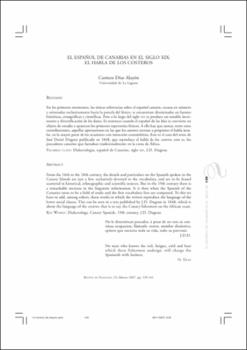El español de Canarias en el siglo XIX: el habla de los costeros
Fecha
2007Resumen
En los primeros momentos, las únicas referencias sobre el español canario, escasas en número
y orientadas exclusivamente hacia la parcela del léxico, se encuentran diseminadas en fuentes
históricas, etnográficas y científicas. Pero a lo largo del siglo XIX se produce un notable incremento
y diversificación de los datos. Es entonces cuando el español de las Islas se convierte en
objeto de estudio y aparecen los primeros repertorios léxicos. A ello hay que sumar, entre otras
contribuciones, aquellas aportaciones en las que los autores recrean a propósito el habla insular,
en la mayor parte de las ocasiones con intención costumbrista. Este es el caso del texto de
José Desiré Dugour publicado en 1848, que reproduce el habla de los costeros, esto es, los
pescadores canarios que faenaban tradicionalmente en la costa de África. From the 16th to the 18th century, the details and particulars on the Spanish spoken in the
Canary Islands are just a few, exclusively devoted to the vocabulary, and are to be found
scattered in historical, ethnographic and scientific sources. But in the 19th century there is
a remarkable increase in the linguistic information. It is then when the Spanish of the
Canaries turns to be a field of study and the first vocabulary lists are composed. To this we
have to add, among others, those works in which the writers reproduce the language of the
lower social classes. This can be seen in a text published by J.D. Dugour in 1848, which is
about the language of the costeros, that is to say, the Canary fishermen on the African coast.






